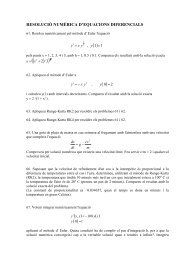Universitat de - Departament d'Astronomia i Meteorologia ...
Universitat de - Departament d'Astronomia i Meteorologia ...
Universitat de - Departament d'Astronomia i Meteorologia ...
Create successful ePaper yourself
Turn your PDF publications into a flip-book with our unique Google optimized e-Paper software.
2 Chapter 1. Introduction and background<br />
Several scenarios have been proposed to explain the X-ray emission of X-ray bina-<br />
ries, <strong>de</strong>pending on the nature of the compact object, its magnetic field in the case<br />
of neutron stars and on the geometry of the accretion flow. In any case, the ac-<br />
creted matter is accelerated to relativistic speeds, transforming its potential energy<br />
provi<strong>de</strong>d by the intense gravitational field of the compact object into kinetic energy.<br />
Assuming that this kinetic energy is finally radiated, we can compute the accretion<br />
luminosity as:<br />
Laccr 1<br />
2 ˙<br />
MaccrV 2 =<br />
GMX ˙<br />
Maccr<br />
RX<br />
, (1.1)<br />
where ˙<br />
Maccr is the accretion rate, V is the free fall speed <strong>de</strong>fined as V = 2GMX/RX,<br />
G is the gravitational constant and MX and RX are the mass and radius of the com-<br />
pact object, respectively. On the other hand, there is a maximum theoretical value<br />
for the accretion rate, when the radiation pressure balances gravity, called the Ed-<br />
dington limit and expressed as:<br />
˙<br />
MEdd = 4πmpcRX<br />
σT<br />
, (1.2)<br />
where mp is the proton mass, c is the speed of light and σT is the Thomson cross<br />
section. The corresponding luminosity can be expressed as:<br />
LEdd = 4πGMXmpc<br />
σT<br />
. (1.3)<br />
In an X-ray binary, the accreted matter carries angular momentum, and on its<br />
way to the compact object it usually forms an accretion disk around it. The matter<br />
in the disk looses angular momentum due to viscous dissipation, which produces a<br />
heating of the disk, and falls towards the compact object in a spiral trajectory. The<br />
black body temperature of the last stable orbit in the case of a BH accreting at the<br />
Eddington limit is given by:<br />
<br />
T<br />
2 × 10<br />
K<br />
7<br />
−1/4 MX<br />
M⊙<br />
. (1.4)<br />
For a compact object of a few solar masses the obtained temperature is ∼ 10 7 K.<br />
At this temperature the energy will be mainly radiated in the X-ray domain of the<br />
electromagnetic spectrum.<br />
Using Eq. 1.1 we can see that for an accreting BH, taking as final radius the<br />
Schwarzschild radius <strong>de</strong>fined as RS = 2GMX/c 2 , the emitted accretion luminosity<br />
is:<br />
Laccr 1<br />
2 ˙<br />
Maccrc 2 . (1.5)






